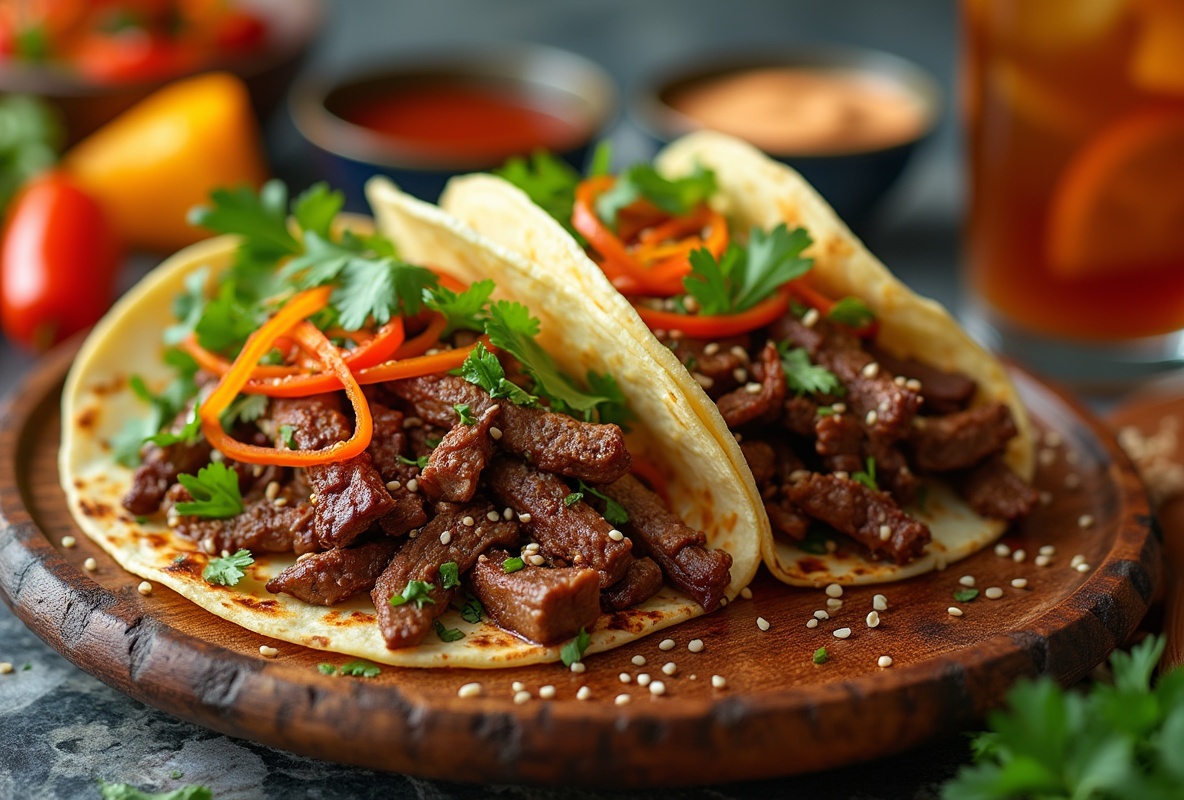Discovering the World of Korean BBQ: An Overview
Exploring Korean BBQ meat cuts can be an exciting culinary journey, full of rich flavors and diverse textures. Whether you're new to this delicious cuisine or a seasoned fan, understanding these essential cuts is key to enjoying an authentic dining experience. From the savory tenderness of steak-like Galbi to the sweet and spicy flavors of thinly sliced Bulgogi, Korean BBQ offers something for every palate. Plus, it's not just about the taste—it's about bringing people together around the grill, creating memories and enjoying the spirit of Korean BBQ.
Essential Korean BBQ Meat Cuts for Beginners
When stepping into the vibrant world of Korean BBQ, choosing the right cuts of meat is essential to a great meal. As a beginner, there are a few standout choices to consider. First and foremost is Galbi. These marinated beef short ribs are a staple in Korean BBQ, offering a sweet and savory flavor that's hard to resist. Another fantastic option is Bulgogi, made from thinly sliced beef soaked in a flavorful marinade. Bulgogi is versatile and perfect for those just starting since it's easy to cook and wonderful in Korean BBQ tacos.
For pork lovers, Samgyeopsal—thick slices of pork belly—cannot be missed. It's simple yet delicious, often enjoyed without a marinade, letting the pork's natural flavor shine. If you're feeling adventurous, try Jumulleok, a tender, lightly seasoned cut that's quickly grilled.
As you embark on your Korean BBQ journey, these cuts will introduce you to the captivating flavors and textures that define this beloved cuisine. Whether you're grilling at home or dining out, these essentials are sure to elevate your BBQ experience.
Exploring the Beef Options: From Galbi to Bulgogi
When it comes to beef in Korean BBQ, there's a diverse array of deliciousness waiting to be explored. At the heart of Korean cuisine, Galbi and Bulgogi stand out as quintessential Korean BBQ meat cuts. Galbi consists of marinated beef short ribs, absorbing a harmonious blend of soy sauce, garlic, and sesame oil. Each bite delivers a satisfying chewiness balanced with a sweet and savory flavor. On the other hand, Bulgogi is celebrated for its thinly sliced beef, often ribeye or sirloin, marinated to achieve a tender and juicy outcome. This makes it a favorite not just in BBQ, but also as a flavorful stuffing for Korean BBQ tacos. Both cuts illustrate the art of marination, where the flavors seep deep into the meat, ensuring an irresistible taste. Exploring these beef options promises a savory adventure, making anyone's Korean BBQ experience unforgettable.
Pork Delights: Samgyeopsal and More
When diving into Korean BBQ, one cannot overlook the succulent joys of pork, starting with the beloved Samgyeopsal. This cut, known as pork belly, is a staple and adored by many for its balance of fat and meat. I love the simple yet delicious way it's typically cooked — often, nothing more than salt is needed to enhance its flavor. The next time you prepare tacos, consider trying some pork belly Korean BBQ tacos for a unique twist!
Aside from Samgyeopsal, there are other pork cuts that are just as delightful. Dwaeji Galbi, or marinated pork ribs, brings a tender, flavorful kick. It’s perfect if you enjoy a sweet and savory profile. Another exciting option is the Moksal, or pork neck, which has a bit more chew but offers incredible flavor absorbed from marinades.
Incorporating these pork cuts into your Korean BBQ could transform your grilling experience and add depth to your culinary adventures. Who knows, you might even impress your guests by whipping up some Korean BBQ tacos with your favorite cuts!
Lesser-Known Cuts That Elevate Your BBQ Experience
When diving into the world of Korean BBQ, you'll find that the lesser-known cuts often bring the most delightful surprises. Have you ever considered adding Korean BBQ tacos to your meal? Let me guide you through some unique cuts that enrich your BBQ spread. Consider cuts like deungsim, or beef ribeye, beloved for its tender marbling and deep flavor. Another gem is the jumeokbap, which is typically overlooked but provides a juicy bite perfect for a robust seasoning. Then there's gopchang, which might be an acquired taste, yet it holds a tempting richness when cooked slowly.
Here's a fun fact: these cuts aren't just for grilling. Their unique textures and flavors make them perfectly suited for Korean BBQ tacos. Toss them into a soft tortilla, add some spicy kimchi, and garnish with fresh cilantro for a fusion dish that will blow anyone’s mind. It's all about experimenting beyond the typical choices and redefining your BBQ experience with these hidden treasures. Get adventurous and try these lesser-known cuts at your next gathering; you might just find a new favorite.
How to Choose the Best Meat for Korean BBQ at Home
When diving into the delicious world of Korean BBQ at home, picking the right meat is key to a lip-smacking experience. But with so many options, how do you choose? Well, let me guide you through my tried-and-true tips!
First, consider the cut of the meat. For beef, short ribs or galbi and thinly sliced brisket are popular choices. Don't forget the bulgogi, which is thinly sliced and perfect for absorbing marinades. If pork is more up your alley, samgyeopsal or pork belly is a must-try.
Next, think about the quality. Look for meat that's fresh, with a good marbling of fat. That's where the flavor bursts from. Don't be afraid to ask your butcher for recommendations – they often know the best cuts for grilling.
For something different and extra sumptuous, you might want to explore lesser-known cuts. These elevate your Korean BBQ experience to a whole new level. Feel adventurous? Try integrating your Korean BBQ meats into new recipes like Korean BBQ tacos for a fusion twist!
Remember, the meat is the star, and with these choices, your home BBQ will be a hit!
Cooking Techniques to Enhance Your Korean BBQ Meat Cuts
Cooking Korean BBQ at home is an art and a joy. Each meat cut offers a unique flavor and texture, and with the right techniques, you can take that experience to a whole new level. Here are a few tips I find particularly helpful:
- Marinating: Begin with a delicious marinade—soy sauce, sesame oil, and garlic are classic choices. A longer marination time enhances the flavors, especially for cuts like bulgogi.
- Grill Temperature: Preheat your grill to a high temperature. Searing your meats quickly at first locks in juices, ensuring they remain tender.
- Thin Slicing: Thin slices can be cooked more evenly. For beef like galbi, slicing against the grain helps in making every bite melt-in-your-mouth tender.
- Resting: Let your meat rest post-cooking. Doing this allows juices to redistribute, keeping your Korean BBQ succulent.
- Sauces and Sides: Don't forget to serve with a variety of sauces and sides to enhance the flavors. They truly transform cuts into a culinary delight, perfect for even creating your own Korean BBQ tacos.
With these methods, your Korean BBQ nights at home can be as satisfying as any restaurant experience!
Frequently Asked Questions
How do I know which meat cuts are best for beginners in Korean BBQ?
If you're new to Korean BBQ, start with popular cuts like galbi (short ribs) and bulgogi (marinated beef slices). These are well-loved for their tender texture and rich flavor. Their popularity means you'll find plenty of recipes and tips to perfect your grill technique.
Are there specific techniques for cooking Korean BBQ meat at home?
Absolutely! For the best results, ensure your meat is sliced thinly. Use high heat initially to sear the outside, then lower the heat to cook it through without drying it out. Don't forget to keep an eye on the marinade to avoid burning!
Can I make Korean BBQ tacos with any type of meat?
Yes, Korean BBQ tacos are incredibly versatile. You can use beef, pork, or even chicken, depending on your preference. Just marinate the meat in Korean flavors, grill it to perfection, and pair it with fresh toppings in a soft taco shell.
What pork cuts should I try if I want something different from samgyeopsal?
If you're looking to explore beyond samgyeopsal (pork belly), consider trying pork jowl or neck. Both are flavorful and offer a unique texture that can elevate your Korean BBQ experience.
How can I ensure the quality of meat for Korean BBQ when shopping?
Start by selecting cuts with good marbling, as this ensures tenderness and flavor. Visit reputable butchers or grocery stores where you can ask about freshness. If possible, choose meat that is labeled as suitable for grilling or BBQ.

